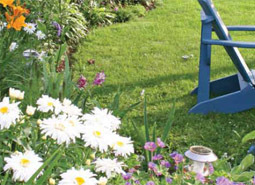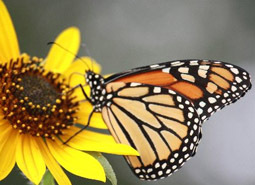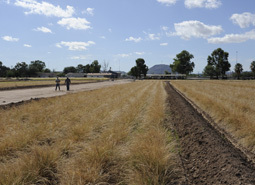About Pesticides
What is a pesticide? A pesticide is a substance used to control unwanted plants, insect pests, rodents, or plant diseases. Pesticides include herbicides, insecticides, rodenticides, and fungicides.Of the pesticides, we believe insecticides cause the greatest challenge to pollinators. Using proper application practices when applying any pesticide is very important in keeping pollinators (and people) safe. Over a 30-year history of SETAC workshops, many groups of renowned scientists have produced summaries that are valued by environmental scientists, engineers, regulators, and managers for their technical quality and comprehensive, state-of-the-science reviews.
General Resources:
- Click here to view a PDF list of recent published pesticide resources including recent work on neonicotinoids.
- Learn more from the Pesticide Environmental Stewardship - Promoting Proper Pesticide Use and Handling.
- Learn more about the Hazards of pesticides to bees - 11th International Symposium of the ICP-BR Bee Protection Group
- Learn more about How to Reduce Bee Poisoning from Pesticides
- USDA and EPA Release New Report on Honey Bee Health - Release Date: 05/02/2013
- Read the latest: SETAC Pellston Workshop on Pesticide Risk Assessment for Pollinators. View the 45 Page Report by clicking here.
- NAPPC Pesticide Education Task Force - Adjuvants 101 (PowerPoint)
For Garden
Everyone can contribute to promoting pollinator health and wellbeing in their community. One way is by creating an inviting habitat with abundant floral resources (pollen and nectar) so that pollinators can meet their nutritional needs and thrive.
You can help ensure bees and other pollinators have access to such resources by contributing to:
Habitat
Pollinators need sustainable places to live, nutritious food to eat and clean water to drink. While land use and development can impact pollinator habitat options, you can provide support by:
- Leaving areas in the garden bare for ground-nesting, solitary species. Leaving hollow logs can also provide nesting habitat for cavity nesting bees.
- Providing a bee hotel or nesting box to serve as homes for solitary bees, such as mason bees or leafcutter bees. Bee hotels with replacement paper or reed tubes are available readymade or are also an easy do-it-yourself (DIY) project. These disposable tubes are important to keep nesting cavities free of fungal diseases and parasites.
- Providing a water source. Adding a bird bath or water feeder with a wet surface made of sand, soil or brick to your yard will allow pollinators to safely collect water without drowning. Providing wet soil, particularly loam or clay, helps some species of bees that collect mud to seal their nests.
- Adding or increasing flower bed areas. You might be surprised to learn which plants pollinators love to visit. Preferred blooms may be those of native plants with smaller and less showy flowers. For more information about which plants are best suited to pollinators in your area, visit websites available from your state’s land-grant university extension office, non-profit organizations, state department of natural resources, or federal agencies. A general rule of thumb is to include native plants, or introduced but non-invasive species, with blue, yellow, or bright white flowers for optimal attraction, along with plants recommended by expert sources. Some good choices also include high pollen or nectar producing trees, fruit-bearing trees, hedgerows, and flowering shrubs. Bees will be more attracted to your garden if there are a variety of plants with different bloom shapes and sizes, particularly if such plants bloom in sequence to provide food throughout the growing season. Clustering flowers of one species can also help pollinators see flowering plants from far away.
Nutrition
Pollinators need nutritious food to survive and thrive. A balanced bee diet includes nectar (sugars/carbohydrates) and pollen (protein and fat) from a diverse array of plants. Some bee species have different nutritional needs than others, so it is important to provide different types of plants for bees to visit. It is also essential to provide a variety of plants that bloom across seasons to provide a continuous food source.
Many pollinators are specialists (as opposed to generalists, like honey bees), or species that only forage on a single plant family. For this reason, it is best to check with your land-grant university’s extension office, experts at your local retail nursery or garden center, or with a professional landscaper to learn about available plants that are good sources of pollen and nectar for specialist species unique to your area.
Plant Health
Planting gardens and containers to attract pollinators may also bring unwanted pests that can harm flowering plants and diminish resources for the pollinators you are working to attract. Pesticides may be one option you choose to control such pests, depending on the seriousness of your pest problem. Whether you are using a synthetic, natural, or organic product, always read and follow all label directions. This ensures safe use and effectiveness for target pests, and compliance with state and federal law.
When using any pesticide but particularly when using insecticides, avoid treating plants in bloom and apply products early in the morning (well before 9:00 a.m.) or in the evening when bees and other pollinators are usually not active or foraging. Pollinators will be most active when temperatures are warmer, so optimum pesticide application timing may change throughout the growing season. Lawn and garden product labels will tell you more, so be sure to read them thoroughly and follow all steps for safe and effective application. Your local university extension office will also offer more information on treating your garden for local pests.
Community
Individual efforts to attract and sustain pollinators in your yard can be scaled up to the community level. Talking with your local community leaders about establishing pollinator habitats in public spaces is one good first step to creating a pollinator-sustaining community. There are funding sources and detailed land management guides available to support these initiatives. Community-supplied bee boxes and planting of low-maintenance perennial flowering trees, hedgerows, shrubs, and perennial wildflowers are simple ways to beautify public and commercial spaces and to put out the welcome mat for pollinators.
For Home

Excerpts below taken from the Solving Your Pest Problems Without Harming Pollinators brochure.
To download the full brochure, Solving Your Pest Problems Without Harming Pollinators, click here.
To purchase the printed versions, visit pollinator.org/brochures.
Pollinator-Friendly Pest Control Strategies for Your Home
Use Integrated Pest Management (IPM) around the home.
- Where possible, avoid pest problems in the first place by burying infested plant residues, removing pest habitat, and planting disease and pest-resistant plant varieties.
- Carefully diagnose your pest problem, and, before you apply a pesticide, make sure the pest population has reached a level where control is necessary.
- Carefully evaluate your pest control options, and use a combination of pest control techniques if appropriate – these may include beneficial insects, manual removal, traps, a pesticide, etc.
- Plant native flowering plant species to support pollinators, choosing species that are naturally resistant to insect pests.
- Many native pollinators such as bumble bees live in natural areas and also play an essential role in pollination. Be especially careful when trying to control pests in or near these areas. All butterflies start life as caterpillars, feeding on plants. Learn what type of insect is eating your plants before you inadvertently kill butterflies and other beautiful and beneficial insects.
If you choose to use a pesticide:
- Read and follow ALL label directions carefully – use the proper rate (not more or less) at the right time for the correct target pests, and avoid re-applying unnecessarily.
- Pay close attention to the Environmental Hazards statement and all pollinator information on the label to determine if special precautions must be taken to protect pollinators.
- The label will tell you if the pesticide should not be used on prebloom or blooming plants, and if the pesticide should only be used when bees and other pollinators are not actively foraging (for example, just before dark). Remember that “prebloom or blooming plants” includes ALL plants - garden crops, ornamentals, weeds, native species, etc. Some labels will indicate if application must be delayed until the blooms and pollinators are gone. If in doubt, do not spray.
- Dispose of unused pesticides properly. (see earth911.com for disposal sites).
- If you handle your pest issues by using pest control professionals, discuss solving your pest problems without harming pollinators.
- If you have questions contact your local extension office (http://www.csrees. usda.gov/Extension/), conservation district (http://www.nacdnet.org/about/ districts/directory/) or visit pollinator.org/landscape-pests where you can get help.
For Monarchs

Excerpts below taken from the Protecting Monarchs brochure.
To download the full brochure, Protecting Monarchs, click here.
To purchase the printed versions, visit pollinator.org/brochures
Monarchs at Risk?
Each fall millions of monarch butterflies migrate to overwintering sites in Mexico and to a scattering of locations along the coast of California. In the spring monarchs return to breeding areas and the cycle starts again: a two-way migration that is one of the most spectacular on the planet. Yet, this migration appears to be declining. Researchers are working to determine the causes of this decline; some theories include:
- Loss of milkweed needed for monarch caterpillars to grow and develop, due to habitat conversion and adverse land management
- Drought conditions in California and other areas in the western U.S., resulting in lower milkweed biomass, and reduced availability of milkweed late in the summer
- Insecticide and herbicide use to control insects and weeds, with unintended consequences for monarchs
- Overwintering habitat loss and degradation in California, due to development within and adjacent to overwintering groves, and decay of overwintering trees as they age
- Habitat loss in overwintering sites in Mexico, due to illegal logging
What You Can Do:
- Help protect monarchs and their migration
- Plant milkweed! Monarch caterpillars need milkweeds to grow and develop. There are over 100 milkweed species that are native to North America, many of which are used by monarchs. To learn which species to plant in your region, and how to plant them, visit the Bring Back the Monarchs Campaign at: www.monarchwatch.org/.
- Plant butterfly nectar plants! Monarchs need nectar to provide energy as they breed, for their migratory journey, and to build reserves for the long winter. Include butterfly plants in your garden, and avoid using pesticides.
- Encourage public land managers to create monarch habitat! Roadsides and parks of all sizes offer great opportunities to create habitat for monarchs and other pollinators.
- Join citizen-science efforts to track monarch populations! The data collected by hundreds of citizen scientists across the country are used by monarch scientists to decipher monarch population trends, and to learn more about what might be driving their numbers from year to year.
- Support monarch conservation efforts. There are a number of monarch conservation efforts underway doing very good work. Please consider donating to support these monarch
For Farms

Excerpts taken from the Pesticide Applicators brochure.
To download the full brochure, Pesticide Applicators, click here.
To purchase the printed versions, visit pollinator.org/brochures
Pollinator Poisoning
Most pollinator poisoning occurs when pollinator toxic pesticides are applied to crops during the blooming period. Poisoning of pollinators can also result from:
- Drift of pesticides onto adjoining crops or plants that are in bloom.
- Contamination of flowering ground cover plants when sprayed with pesticides.
- Pesticide residues being picked up by foraging pollinators and taken back to the nest/colony.
- Pollinators drinking or touching contaminated water sources or dew on recently treated plants.
Remember, YOU, the Pesticide Applicator, are critical to reducing pesticide risk for pollinators.
Use pesticides only when needed.
Check for “Bee Hazard” warnings and pollinator precautions in the Environmental Hazards statement and in the directions for use on the label. Consider the toxicity to pollinators when selecting a pesticide and formulation and when combining products.
Guard against drift of pesticides from ground or aerial applications.
Bloom is a key factor in pollinator exposure to pesticides. When crops or ground cover plants are in bloom:
- Apply non-ERT (“actively visiting”) pollinator-toxic pesticides in late evening to minimize exposure to pollinators.
- Do not apply ERT (“visiting”) pollinatortoxic pesticides.
- Avoid applying when lower temperatures will allow dew formation. Dew may re-wet pesticides and increase bee exposure.
- Avoid spraying areas where native pollinators live such as hedge rows and natural areas.
- Establish good relations and communication with commercial and local beekeepers.
How to Read a Pesticide Label
Produced by the North American Pollinator Protection Campaign (NAPPC) Pesticide Education Task Force
The “good bugs,” pollinators like bees, butterflies, beetles and more, are vital players in healthy ecosystems. Their protection is part of your responsibility when you use a pesticide, but also one of the reasons that precautions are put on the labels of products is that they may be particularly toxic to pollinators if misused. Pay attention; read and follow the label; look for key words; try to prevent infestation.
The US Environmental Protection Agency (EPA) regulates the information that must be included in the label of any pesticide product. EPA has a web site that will also give you further information about a product's efficacy, label cautions, and more. These can be found at: https://www.epa.gov/pesticide-labels and https://iaspub.epa.gov/apex/pesticides/f?p=PPLS:1.
Thank you in advance for taking extra care with any application and disposal of a household chemical!
Helpful Links:
- Information on beneficial insects
- EPA Brochure on WHY to read labels
- Protect your household
- Protect your kids
- Protect your garden
- Protect your pets
- http://www.ipmcenters.org/
- https://www.extension.org/
- http://npic.orst.edu/envir/index.html
- For gardeners
- For professional applicators
- Pesticide Database
P2's Position
Pollinator Partnership (P2) believes that the unwarranted use of all chemical pesticides (including insecticides like neonicotinoids, pyrethroids, carbamates, and organophosphates) must be eliminated. Download the PDF.
P2’s goal is to reduce the impact of pesticides on pollinators. Too many people use pesticides as a first line of defense or as an insurance policy, but if one is insuring for a problem that doesn’t exist or is not justified by a demonstrated need, the use of pesticides becomes an insurance policy that asks pollinators to pay the premium. Pesticides must be used to treat pests only when there is proven economic impact, and even then, the choice of a specific pesticide, application method, time-of-day, climatic conditions, and bloom season should be considered so that pollinators are protected from harm to the greatest extent possible.
A 2016 University of Maryland study by vanEngelsdorp, et al. found 93 chemical compounds in the bee hives they studied and as many as 20 compounds in a single hive. Clearly, there are many chemicals impacting honey bees and other pollinators. Promoting chemical-by-chemical bans may reduce this threat, but it won’t prevent users from switching to other chemicals that could be more harmful nor address all the new chemicals that are in the pipeline. Similarly, generalizations are not helpful in solving real problems that are both complicated and context-specific. Bans that ignore subtle but significant issues not only alienate the very constituents who must be engaged to protect pollinators, namely farmers, but may also drive them to use other problematic practices and products that can harm pollinators.
P2 advocates Integrated Pest Management (IPM) which shifts away from automatically turning to chemicals for prevention and solutions. IPM encourages a wide variety of practices that systematically address pest management; and most importantly, aims to prevent pest problems from occurring in the first place. IPM provides a powerful set of tools to change behaviors in order to reduce risk and exposure and to support healthy pollinators, healthy farms, and healthy gardens. P2 also advocates for easily understandable labels that give clear directions on pesticide uses and the best means of ensuring pollinator health.
P2 is eager to see data on the effects of the European moratorium on neonicotinoid insecticides on crops that attract bees. The growing evidence of harm to non-target organisms from certain neonicotinoids points to a significant need to reduce their prophylactic use, especially where there is no history of infestation or demonstrated economic threshold that has been met in any given crop or location. Each neonicotinoid that is used on crops (acetamiprid, clothianidin, imidacloprid, dinotefuran, thiacloprid and thiamethoxam) has different uses, effects on pollinators, and inherent properties, including persistence rates in soil and water, which are affected by factors such as exposure to UV light, temperature, and soil type. Insecticides, like the six neonicotinoids listed above and other systemic compounds like sulfoxaflor and flupyradifurone, or pyrethroids, carbamates, and organophosphates, are intended to kill insects. In addition to insecticides, fungicides and herbicides alone or in combination can also be problematic to pollinators. Recent research shows that adjuvants and surfactants that are used in combination with the active ingredients (AI) can also be harmful to pollinators. Further, the overuse of chemicals sets the stage for the development of resistance, necessitating the need for new chemicals which perpetuates the cycle of overuse.
P2 is working to encourage the increased use of IPM and related approaches to managing pest problems that ensure pollinator health is considered at every decision point. P2’s operating model is based on a collaborative approach, and it will continue to help move partners and other interested stakeholders forward to optimal pollinator health in every landscape.